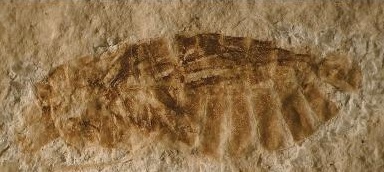In Bavaria, the Tithonian Konservat-Lagerstätte of lithographic limestone is well known as a result of numerous discoveries of emblematic fossils from that area (for example, Archaeopteryx).
Now, for the first time, researchers have found fossil insects in the French equivalent of these outcrops – discoveries which include a new species representing the oldest known water treader.

Despite the abundance of fossils in the equivalent Bavarian outcrops, fewer fossils have been obtained from the Late Kimmeridgian equivalents of these rocks in the departments of Ain and Rhône in France. Many outcrops are recorded (for example Cerin and Orbagnoux), but the fauna found there is essentially of marine origin, being made up of crustaceans and fishes. Some layers have provided dinosaur footprints, but until today’s announcement the only known terrestrial organisms were plant remains transported into the ancient lagoons.
During the course of two field expeditions in 2012 and 2013 French researchers working with the help of two active teams of amateur scientists (Société des Naturalistes et Archéologues de l’Ain and the Group ‘Sympetrum Recherche et Protection des Libellules’) discovered the first insects from the Orbagnoux outcrop, together with traces of activities of these organisms on leaves and in the sediment.
The newly discovered insect was described today, in the open access journal PeerJ. The bug was 6 mm long and is the oldest record of the aquatic bug lineage of the Gerromorpha which comprises the water striders and the water measurers. This is the oldest known water treader (Mesoveliidae), the sister group of all other gerromorphan lineages. In a similar manner to some of its recent relatives, this aquatic bug could have lived in brackish environments.
In addition, traces of insect activity on plants were found, comprising surface feeding traces on Zamites leaves. Such traces are quite rare in the fossil record and in this situation they demonstrate the presence of strictly terrestrial insects on the emerged lands that were surrounded by these Jurassic lagoons.




